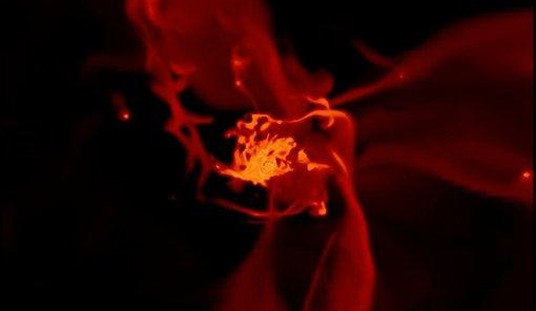Don’t look now, global warmists, but National Geographic just put some science to one of James Hansen’s most outlandish claims.
In his book Storms of my Grandchildren, noted climate scientist James Hansen issued the following warning: “[I]f we burn all reserves of oil, gas, and coal, there is a substantial chance we will initiate the runaway greenhouse. If we also burn the tar sands and tar shale, I believe the Venus syndrome is a dead certainty.”
Keep your eyes on the ball here. Hansen doesn’t give us a number, but does say that Earth stands a “substantial chance” of going hot like Venus and burning off all our oceans if we were to burn up all of our reserves of oil, gas and goal.
What’s a “substantial chance?” And does it matter that Venus is only 67 million miles from the Sun, while Earth is 93 million miles from the Sun?
You’d think it would. It does.
Respected as Hansen is, the argument hasn’t convinced climate scientists who specialize in the evolution of planetary atmospheres. During the Paleocene-Eocene Thermal Maximum (PETM), 56 million years ago, a huge natural spike in CO2 sent temperatures on Earth soaring—but life went on and the ocean remained intact.
“I think you can say we’re still safe against the Venus syndrome,” says Raymond Pierrehumbert of the University of Chicago. “If we were going to run away, we’d probably have done it during the PETM.”
Maybe Hansen shouldn’t be so respected. I know from my years at NASA that among the staff who worked nearest him at the Goddard Space Flight Center and had to deal directly with him, he wasn’t.
NatGeo asked Colin Goldblatt of the University of Victoria in British Columbia to weigh in on Hansen’s alarmism. Goldblatt has modeled Hansen’s ideas. Turns out, Hansen is off. Way off.
What does your work say about Hansen’s warning?
What my results show is that if you put about ten times as much carbon dioxide in the atmosphere as you would get from burning all the coal, oil, and gas—about 30,000 parts per million—then you could cause a runaway greenhouse today. So burning all the fossil fuels won’t give us a runaway greenhouse. However, the consequences will still be dire. It won’t sterilize the planet, but it might topple Western civilization. There are no theoretical obstacles to that.
Goldblatt leaves science behind at the end there when he starts talking about toppling civilization, but keeping our eyes on the ball, Hansen is off by a factor of ten with respect to how much burning it would take to turn Earth into Venus. A factor of ten is a lot.
Yet even with that large an error, NatGeo tries rehabilitating Hansen’s alarmism:
In a paper published this week in Nature Geosciences, those calculations have rippled into a simple climate model. The paper’s conclusion contains this slightly unsettling sentence: “The runaway greenhouse may be much easier to initiate than previously thought.”
Not really. You’d need ten times the known quantities of gas, oil and coal just to make Hansen’s runaway greenhouse effect possible. Then you’d have to burn it more or less all at once, which we can’t do. And then, you’d still need to take into account the atmospheric effect of clouds, which Goldblatt’s model doesn’t do.









Join the conversation as a VIP Member